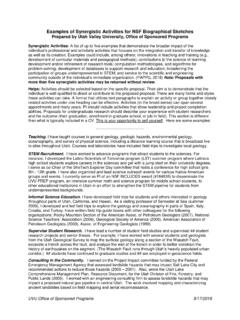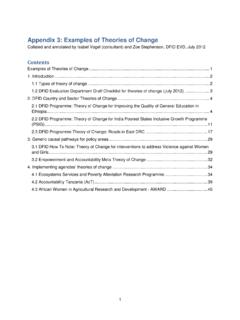Transcription of Teachers Matter: Attracting, Developing and Retaining ...
1 Teachers Matter: attracting , Developing and Retaining Effective Teachers POINTERS FOR POLICY DEVELOPMENT Table of Contents Teachers matter: Main concerns and common policy priorities .. 5 Why is teacher policy important? .. 7 Making teaching an attractive career choice .. 9 Developing Teachers knowledge and skills .. 11 Recruiting selecting and employing Teachers .. 13 Retaining effective Teachers in schools .. 15 About us: Education and Training Policy Division .. 17 These general pointers for policy development are drawn from the Thematic Review on teacher Policy and the findings are presented in Teachers Matter: attracting , Developing and Retaining Effective Teachers , published in 2005.
2 Country background reports prepared by 25 countries, country reviews of 10 countries and other documents are on the OECD website Directorate for Education, Education and Training Policy Division September 2011 5 Teachers matter: Main concerns and common policy priorities M AIN C O NC ER NS Although the information is often patchy a broad picture of concerns across countries has emerged about: qualitative shortfalls: whether enough Teachers have the knowledge and skills to meet school needs limited connections between teacher education, Teachers professional development, and school needs maintaining an adequate supply of good quality Teachers , especially in high demand subject areas the image and status of teaching -- Teachers often feel that their work is undervalued long term trends in the composition of the teaching workforce, fewer high achievers and males sometimes high rates of teacher attrition, especially among new Teachers the impact of high workloads.
3 Stress and poor working environments on job satisfaction and teaching effectiveness limited means in most countries to recognise and reward Teachers work in some countries, a large over-supply of qualified Teachers , which raises its own policy challenges inequitable distribution of Teachers among schools, and whether students in disadvantaged areas have the quality Teachers that they need Retaining effective Teachers implies not only that all Teachers have opportunities, support and incentives to continue to improve and perform at high levels, but also that ineffective Teachers do not stay in the profession. School systems often respond to teacher shortages in the short term in ways that raise concerns about the quality of teaching and learning.
4 They ensure that classrooms have Teachers by some combination of: lowering qualification requirements for entry to the profession assigning Teachers to teach in subject areas in which they are not fully qualified increasing the number of classes that Teachers are allocated increasing class sizes P O LIC Y OR IE NT AT IO NS T O M E ET KE Y PO LIC Y OBJE C T IVE S Policies aimed at attracting and Retaining effective Teachers need to recruit competent people into the profession, and provide support and incentives for professional development and on-going high performance. Teachers may not reach their potential if settings do not provide appropriate support, challenge and reward.
5 Policy initiatives need to improve status and labour market competitiveness, and to improve teacher development, and school work environments for the teaching profession as a whole. They also need to focus on attracting and Retaining particular types of Teachers , and attracting Teachers to work in particular schools. Tackling one area without enough attention to inter-related aspects will lead to only partial results. But it is difficult to address all areas simultaneously, and resource constraints mean that trade-offs are inevitable. C O MM O N PO LIC Y P R IORIT IE S Most Teachers are employed in the public sector in either career-based or position-based systems.
6 In career-based systems, Teachers enter when they are young and the entry criteria are usually demanding. Teachers are normally allocated to posts according to internal rules and promotion is based on a system of grades attached to the individual rather than to a specific position. Directorate for Education, Education and Training Policy Division September 2011 6 Position-based public services select the best candidate for each position, by external recruitment or internal promotion. Entry from other careers is relatively common. Personnel selection and management is often decentralised to schools or local authority offices. Despite major differences between these public service traditions, they share some common policy priorities.
7 Emphasising teacher quality over teacher quantity Developing teacher profiles to align teacher development, performance and school needs Viewing teacher development as a continuum Making teacher education more flexible Transforming teaching into a knowledge-rich profession Providing schools with more responsibility for teacher personnel management DE VE LO P ING AND IM P L E M E NT ING T E ACH E R POLIC Y Teachers themselves need to be actively involved in policy development and implementation and feel a sense of ownership of reform -- otherwise it is unlikely that substantial changes will be successfully implemented. Teaching Councils provide Teachers and other stakeholder groups with a forum for policy development and a mechanism for profession-led standard setting and quality assurance in teacher education, teacher induction, teacher performance and career development, combining professional autonomy and public accountability.
8 Policy has a key role in helping Teachers to develop professional learning communities within and beyond schools with Teachers actively analysing their own practice in the light of professional standards, and their own students progress in the light of standards for student learning. Directorate for Education, Education and Training Policy Division September 2011 7 Why is teacher policy important? QUAL IT Y T E AC H ING IS VIT AL FO R IM P R O VING ST UDE NT LE AR NING Student learning performance varies widely among students of a similar age. In some countries the difference between 15 year-old students in the top and bottom bands of reading performance is equivalent to the effect of several years of additional schooling.
9 Student learning is influenced by many factors. Research on student learning shows that The largest source of variation in student learning is attributable to differences in what students bring to school their abilities and attitudes, and family and community background Of those variables potentially open to policy influence, factors to do with Teachers and teaching are the most important influences on student learning. In particular, the broad consensus is that teacher quality is the single most important school variable influencing student achievement Many important aspects of teacher quality are not captured by the commonly used indicators such as qualifications, experience and tests of academic ability.
10 teacher characteristics that are harder to measure, but which can be vital to student learning include the ability to: convey ideas in clear and convincing ways create effective learning environments for different types of students foster productive teacher -student relationships be enthusiastic and creative work effectively with colleagues and parents T E AC H ER S AR E T H E M OST S IGNIFIC ANT AND C OS T LY R E SO UR CE IN S C HOO LS As the most significant and costly resource in schools, Teachers are central to school improvement efforts. Improving the efficiency and equity of schooling largely depends on ensuring that competent people want to work as Teachers , their teaching is of high quality and all students have access to high quality teaching.


















